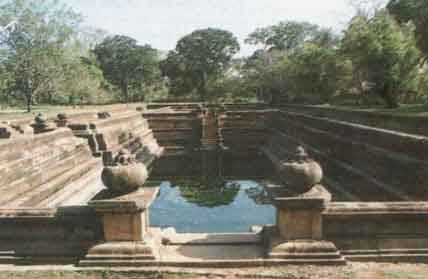
The twin ponds are magnificent examples of landscaped architecture built on a grand
scale. The ponds are in fact not twins at all, pond (b) being longer by forty feet, than pond (a) The stone
modeling of the baths and the flights of steps leading to the water are graceful and austere, but above all
natural. At the head of the steps are pairs of the stone vases, or pots of plenty, resting on lotus pedestals.
Apart from their beauty, the twin Ponds are very functional. The massive stone sides are built into the solid
rock, so that the water stays both clean and cool. The walls are built in tiers so the monks could sit with
their feet in the water and bathe.

At the far end of pond (a) is an inlet, with a system of trapping mud and dirt. The
water flows into a pit, where the mud and dirt sinks to the bottom, and the water flows out in to outer rim.
The water runs in to the final chamber from which clean water gushes out in to the pond, through a lions-head
spout. Beside this spout is a beautiful naga-stone, perhaps the best in Anuradhapura. The water eventually
drains away from the bottom of the pond (b). These ponds are perhaps the best surviving examples of landscaped
architecture in Anuradhapura, and were beautifully conserved by the Archaeology Department thirty years ago.
For hundreds of years the monsoon rains of Sri Lanka have washed away brick and cement, but massive stone
architecture survives intact, even if in disorder.






